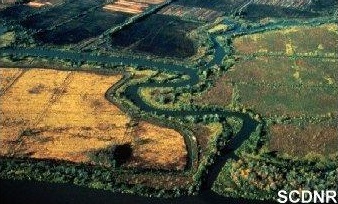Characterization of the Ashepoo-Combahee-Edisto (ACE) Basin, South Carolina

Humans have lived and utilized natural resources in the ACE Basin for thousands of years. The first human presence in the Basin occurred approximately 6,000 years ago with the Paleoindians. Like their Asian counterparts, Paleoindians are believed to have lived in mobile hunter-gatherer groups and hunted large animals such as mammoths and mastodons. New ways of hunting and gathering marked the end of the Paleoindian period and the beginning of the Archaic period and the modern-day Indians. Until the arrival of Europeans in the sixteenth century, Paleoindian culture evolved into a more sedentary society that relied on hunting in smaller territories and agriculture. Semipermanent villages of several families were built near the hunting grounds. Villagers tilled and planted crops such as corn, beans, and squash during the spring and harvested in the fall. During the summer months, the entire village moved to the homesteads near the coast, where they subsisted on seafood and wild plants, particularly roots.
Bear Island impoundmentsHuman activities have shaped the history, and the cultural and natural resources of the Basin. Early Carolinians cleared thousands of acres of old-growth hardwood forests and planted a variety of crops including corn, tobacco, and root crops. Tens of thousands of acres of bottomland hardwoods along the navigable rivers and creeks of the ACE Basin study area were converted to rice fields (McCrady 1897). Lumber companies of the late 1800s to early 1900s logged most of the virgin pine forests and swamplands in Colleton County. The modernization of farming practices after World War II resulted in extreme increases in profit and crop production (Gliessman 1998). Improvements in farming techniques, and the construction of the Intracoastal Waterway, roads, and railways were instrumental in promoting the development of the farming industry during the early twentieth century. Today, the extensive pine plantations and rice field systems established during this period are still evident.

Many of the large plantations that once supplied the mills with timber were converted to hunting preserves. The abandoned rice fields and logged forests attracted a rich abundance of game animals, including migratory waterfowl and deer to the area. The interest in hunting led to the evolution of sophisticated wildlife management techniques that help to preserve the natural quality of the ACE Basin study area that we enjoy today.
Most of the more well-known archaeological sites in the ACE Basin date from the recent historic period, particularly the 18th and 19th centuries when the area flourished as a prosperous agricultural region. Some of the more popular historic attractions around the ACE Basin study area include the Colleton County Courthouse, Hunting Island Lighthouse, and Edisto Beach State Park. It is important to recognize that although hundreds of sites have been formally recognized, hundreds to thousands of sites may never be discovered without careful site planning, inventories, and management during land clearing. The use of appropriate planning, identification, and preservation of these cultural resources will sustain them for tourism and future generations.
